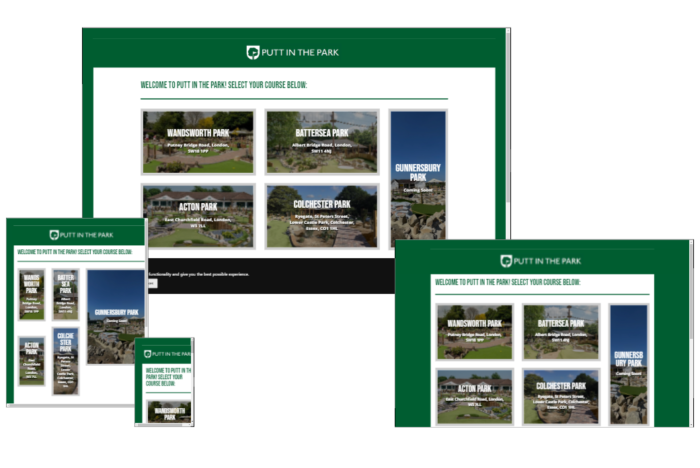This Is How A Successful Website Works
Regardless of whether you are setting up a brand new website, or restructuring an existing one that has not been fulfilling its true potential, the best starting point is to understand how a website really works and to appreciate how potential customers arrive at your website and what presses the right buttons for them.
Our primary role is akin to a golf coach making sure you are lined up correctly, with good posture and a conventional way of gripping the golf club. Once all the fundamentals are checked and in place, and that you have a basic understanding of the chain reaction involved in hitting the ball in the right direction, you’ll be on the fairway more often and will enjoy – and get more out of – the game more as a result.
To begin with, it’s worth just reminding yourself how a successful website actually “works”. What’s important – and why.
One of the main things that successful businesses have in common are websites that do everything possible to build customer confidence and support their business as a whole. It doesn’t matter how large or small a business is, or what field it is operating in – the more the website does, and the more automated it is in doing it, the more efficient your website will be in generating enquiries/revenue and being administrated. The more that can be handled online, the more efficient your business will be. If you haven’t noticed already, when you try and deal with any large corporation these days, you are always directed to go online to complete your request or query. Much as we all might try and fight it for as long as we can, it’s where we are all gradually being shepherded.
Although every business has a website, very few actually understand what makes the difference between an average one and a successful one. It’s not money – although that can help – it’s more to do with understanding what a customer expects – even before they’ve even heard of you or your business.
Firstly, imagine the scenario where you are talking to someone about your business. You come across as the sort of person they want to do business with. They Google you afterwards – either by name or through what you do. Is your website doing everything it can do to continue the initial customer confidence you’ve created in your initial contact? Especially since you are not “there in person” to answer questions or to guide them through what you can do for them.
Secondly, imagine the scenario whereby a customer has never heard of you but searches for what they are looking for using logical search phrases or key words, or is responding to an ad or a social media post. Is your website doing everything it can do to build customer confidence “in your absence” and let them make the decision to choose you to do business with? Especially since looking at your website is the only contact they will have from anyone within your operation, at least until after they have made their decision.
Your website is the public face and focal point of your business. It should ALWAYS be the very best that it can be – an up to date statement of your operation as it stands today and every day. It represents you 24 hours a day, 7 days a week. You want to be proud to direct people to it, safe in the knowledge that it will build customer confidence and equip them with all the information that they need to know in order to do business with you. If it was a real person, you’d insist that they were dressed smartly, knew their stuff, were able to convey information about your products or services eloquently, and were either able to “close the deal” themselves or to direct them to whoever they needed to speak to.
And there’s the added benefit that a website doesn’t get sick or need holidays either! It just needs a bit of love from time to time!
No matter how much a website evolves in the future, there is a natural flow with the entire process of how a customer becomes a customer – from their initial thought process in finding you and visiting your website, all the way through to what they expect to see and how it influences their decision to choose you to do business with.
If all the key fundamentals are in place, and are in the right order, they collectively make a huge difference to customer confidence in your website, and therefore your business as a whole.
This is the mental journey that customers undertake and the factors they – consciously and sub consciously – take into consideration when assessing you. This is how a successful website works:
Being found via Google and other search engines using relevant words or phrases
Potential customers expect to be able to find your site – and relevant pages within it – using various combinations of relevant phrases or words. Every business can influence search engine results by ensuring that some basic, simple procedures are in place. Google factors in how your individual page titles and descriptions – and the content on the pages themselves – are set up when ranking your site. If this is not set up properly, Google will use its own algorithm to interpret your site content. It’s a simple process to set this up correctly and if done thoroughly, it will further quicken the search process by taking them to the most relevant page of your website. If your website can be found quite easily and it takes them through to a relevant result, it immediately builds confidence. No one likes searching longer for anything than they have to!
Security & website loading time
Potential customers expect to see that your website is secure and encrypted. An SSL Certificate shows customers that you take their security and privacy seriously, and Google also ranks sites with an SSL Certificate higher. Customers also expect websites to load fast – no one likes waiting for sites to connect or pages to load.
Responsive, Mobile friendly website design
Nearly everyone browses via a mobile device – as well as desktop or laptop computers – so it is essential that your website responds to whatever device it is being viewed by. This also means ensuring the content displays in the same logical order for each device too, so it flows and makes sense to customers.
Clean looking, uncluttered design, easy to navigate
Whilst it’s great to integrate new functions and features that make a website more dynamic and “alive”, it’s important to stress that the core design should be clean, uncluttered and easy to navigate. No one likes to be overwhelmed. The idea is to build immediate customer confidence in your operation as a whole, and to then direct them to specific pages that are relevant to them.
Well written, neatly presented up to date content that sells your products/services to the customer
Now that the customer has found you and likes what he sees, it is essential that you REALLY tell them what it is you do and/or what the benefits are to them. This is where you sell! Content needs to be well written and neatly presented. They expect to see good quality images, if relevant. Customers really do notice typos, spelling mistakes, missing images, broken links, graphics that don’t work and other odd combination layouts. They also notice things that are supposed to be “clever” but which don’t work properly or which detract from the overall experience of the site as a whole. They also notice if a website has not been updated for a while, or if it is generally looking a bit unloved or unattended – the website might be live, but does that mean you are still in business? These sort of things start to reduce all the customer confidence that has been generated through the process so far. In short, make sure you give them what they expect and want.
Call to Action!
Having lead your customer this far on the journey, they expect to be told what it is they need to do next. ie, what you want them to do about it – to call you, to complete a form, to book/buy online, to visit you etc. And, you need to reassure them about what happens next? When can they expect to hear from you? What level of support they are going to get afterwards too?
Conclusion
They expect the site to be easy to find. They expect it to work on computers, tablets and phones. They expect the site to include modern features (ie you’re going places, not standing still!), be easy to navigate, and to contain up to date, well written and neatly presented content. It’s important they know they can trust the information they see is accurate. They also expect the site to be secure, always available and to load fast. A website with a glitch, or running slowly, or containing factually incorrect content incurs lost revenue, and without proper attention an issue can go unnoticed for ages.
Collectively, all the above make a difference. If – from beginning to end – everything happens just like a customer hopes it will happen, every “box” in their mind is ticked. Maybe there’s even relief that they can stop looking! It is all common sense really. When you first “meet” someone or search for a business, and then go through the process of doing business with them, these same thoughts go through your head. Your customers are no different.


